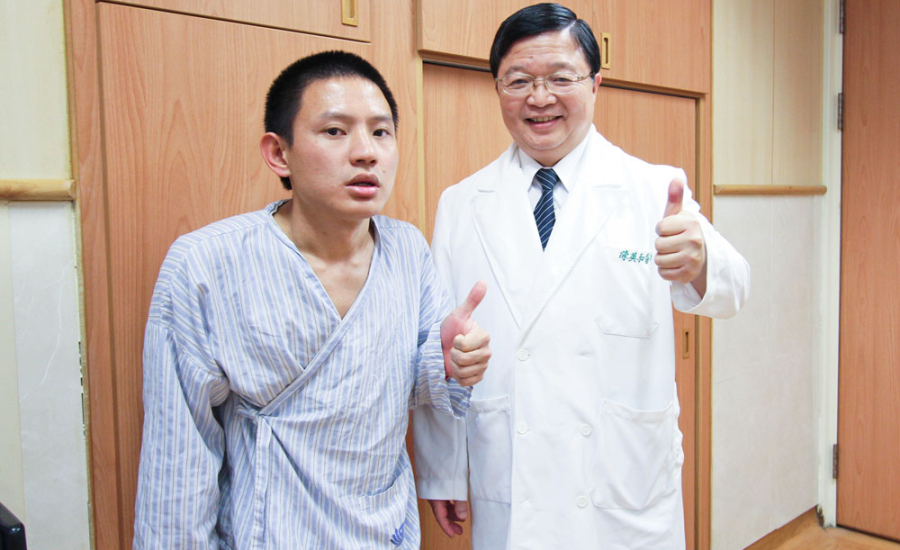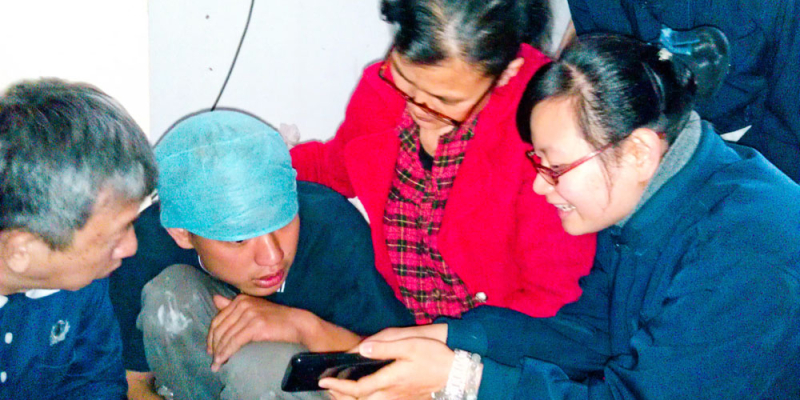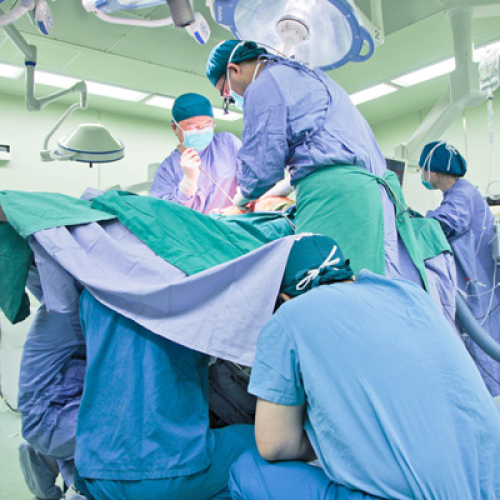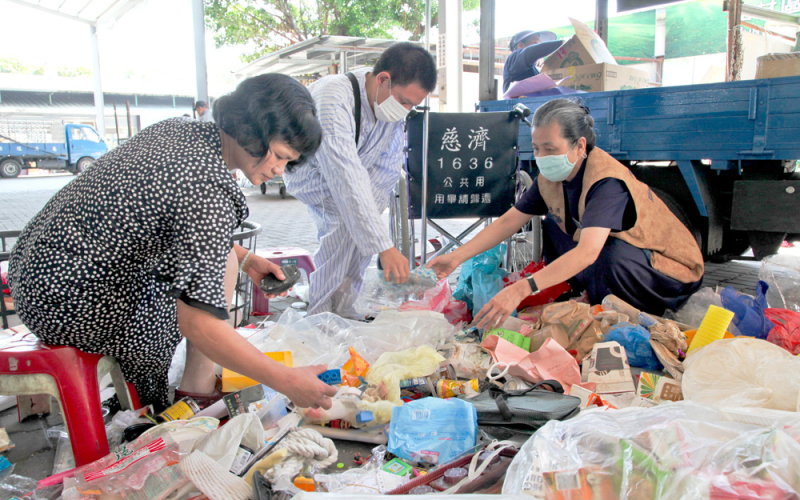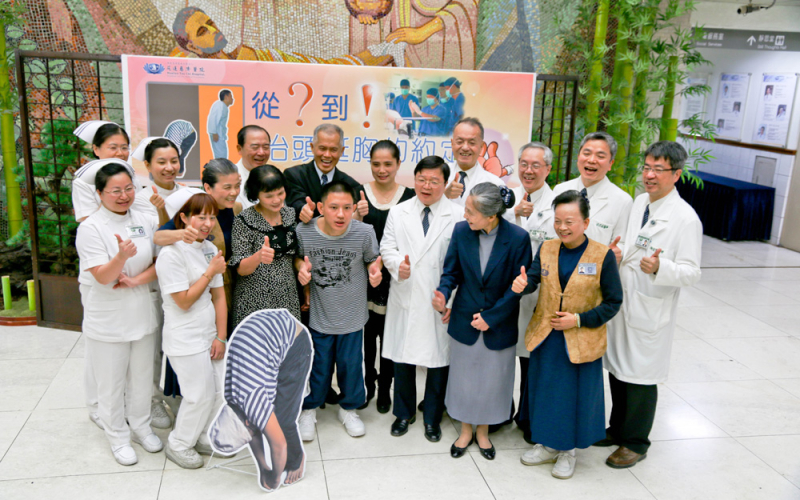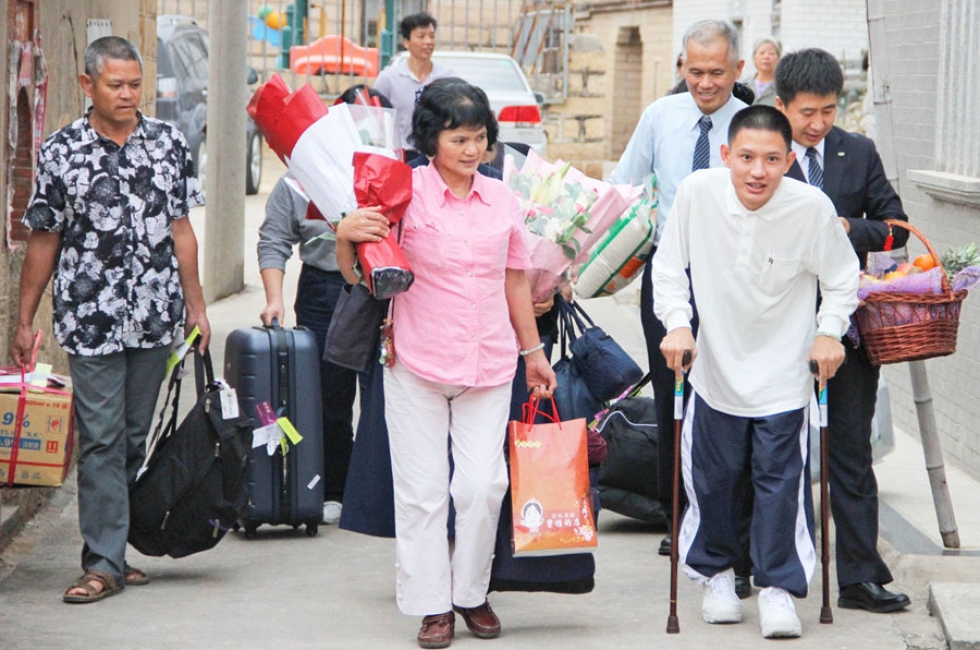Treatment of Ankylosing Spondylitis at Hualien Tzu Chi Hospital
Written by Wei-Ting Wei
Ankylosing spondylitis will gradually affect joints
in the spine and nearby tendons and ligaments,
and the progression of this chronic disease
will lead to the calcification of the spine.
In severe cases,
the patients will not be able to stand up straight.
In May 2013, Xiao-Dong Yang, suffering from ankylosing spondylitis,
flew across the strait of Taiwan with the assistance of Tzu Chi
volunteers from Xiamen,
to receive surgical treatments in Hualien Tzu Chi Hospital.
A disease so severe,
it left Yang bent over 200 degrees,
with his face against his knees.
Since the first successful treatment 22 years
ago by Honorary Superintendent Ing-Ho Chen
with pedicle subtraction osteotomy,
Dr. Chen has successfully treated over 220
cases of ankylosing spondylitis.
After five corrective surgery and rehabilitation
over a five month period,
Xiao-Dong Yang’s spine gradually improved
from ? to !.
With the love and effort from the medical team
and the volunteers,
smile finally returned to his face,
as he walked home with head up high.
A 31 years old youth with a face of a 15-year-old, what
stopped his time from flowing?
What kind of secrets force him to hide his face, like a
punished child, shunned away from the world?
That spine, bent over 200 degrees, shackled his youth,
silenced his voice to the outside world.
Xiao-Dong Yang, born in Xiamen, China, believed he had poliomyelitis. He rejected the world ever since with indifference and silence. It was not until the Xiamen Tzu Chi volunteers visited him time and again, did he finally let down his guard and spoke again, as well as willing to visit the local hospital for further examination despite fear and discomfort.
Honorary Superintendent Ing-Ho Chen of Hualien Tzu Chi Hospital evaluated the examination results from Xiamen and confirmed it to be severe ankylosing spondylitis. The treatment is a complex one, yet Chen was willing to design a treatment plan tailored to Xiao-Dong’s conditions. On May 23 2013, Xiamen Tzu Chi Volunteer ZhouMing Chen, accompanying Xiao-Dong and his mother, carried Xiao-Dong on and off the plane, trains and cars, all the way from Xiamen to Hualien Tzu Chi Hospital for treatment.
Xiao-Dong Yang, isolated from the world due to severe ankylosing spondylitis, was introduced to Tzu Chi Foundation by Xiamen Charity Federation and finally had the chance to change his fate.
Xiao-Dong Yang, now 31 years old, was a zestful child born at Xiamei Village, Xiang’an District, Xiamen, China. Ever since he was 12 years old, Xiao-Dong constantly claimed aching in the thighs and spine, and he began to limp as well. His anxious parents took him to visit doctors near and far, western and Chinese; yet even with costly herbs and medication, Xiao-Dong’s condition never seem to improve. His spine continued to bent and limbs deformed. This peculiar physique made him a target for mockery and bullying. He stopped attending school, shut the world away, confined himself in his room and stayed isolated for the next 19 years.
Walking, eating, sleeping, actions that are seemingly simplistic and natural to others became a nightmare for Xiao-Dong. For the past 19 years, he lived with his back bent over 200 degrees, face against his knees. His dream was to sleep on his back, to walk with his head up high.
During the X-ray, the radiology team trying to find the most appropriate posture for Xiao-Dong. During the treatment period, the medical staff accompanied Xiao-Dong to the Jing Si Abode, Master Cheng Yen encouraged XiaoDong to stand up straight and be taller next time they met.
January 2013, Tzu Chi Foundation Xiamen Chapter received XiaoDong’s case from Xiamen Charity Federation and paid Xiao-Dong a visit. It was then the volunteers discovered that Xiao-Dong’s father had passed away five years earlier and his mother had a car accident on November the year before. As result of the accident, his mother, Jin-Chai Zhu, had a steel rod implanted in her left thigh. The rod broke soon after the surgery, which left Zhu unsupported and unable to work. Both Zhu and her son were in dire need of medical assistance.
Shi-Jian Pan, Vice Chairman of CPPCC Xiamen, helped Yang’s family to apply for low-income household subsidy to solve their immediate needs. To further understand Xiao-Dong’s condition, Tzu Chi volunteers took Xiao-Dong to a major hospital in Xiamen to assess the possibility of surgical treatment. “It is harder than landing on the moon, impossible!” The doctor at Xiamen replied after reading the reports, which devastated the hope of Xiao-Dong and his mother. Tzu Chi volunteers, unwilling to give up, transferred Xiao-Dong to Hualien Tzu Chi Hospital. Ing-Ho Chen, the honorary superintendent of Hualien Tzu Chi Hospital, an orthopedic surgeon who had treated over 170 cases of ankylosing spondylitis patients, assessed Xiao-Dong’s condition and agreed to operate. With the effort of Vice Chairman Pan, Xiamen Charity Federation and the Tzu Chi volunteers, Xiao-Dong finally departed on his medical journey on May, 2013.
On the eve of May 23, Xiao-Dong and his mother arrived at Hualien Train Station. On the platform, Hualien Tzu Chi Hospital Vice Supt. WenLin Hsu, orthopedic surgeon Kuan-Lin Liu, Deputy Director Hui-Mei Yen of Social Service waved at them. Vice Supt. Hsu pressed his thumbs passionately against the window where Xiao-Dong was seated, and, to everyone’s surprise, Xiao-Dong pressed his thumbs on the window, against Vice Supt. Hsu’s thumbs, with a smile. His small step forward was a major progress for everyone, since XiaoDong, who had been silent for the past 19 years, would only respond to others’ greetings with a slight nod and observe the world from behind his sunglasses.
On the second day of his arrival, Hualien Tzu Chi Hospital arranged a series of examination for Xiao-Dong. Since Xiao-Dong was literally bent in half, it posed a great obstacle for the medical team. The radiologists brainstormed and found the best posture to squeeze Xiao-Dong into the scanner and complete MRI, CT scan, X-ray, ECG, echocardiography and pulmonary function tests. With a 3D image model as reference, the orthopedic surgeons were able to design a complete medical treatment plan.
Spinal correction osteotomy is a complex and progressive procedure. Supt. Ing-Ho Chen(left) the chief surgeon, and a team to pull and straighten Xiao-Dong’s deformed physique, worked together to complete the complicated surgery.
“Can I lie down flat on the bed if I receive surgeries on both sides (of the hip)?” Xiao-Dong asked away his greatest doubt and wish the moment he met Ing-Ho Chen. It was a normal posture for people to sleep in; for Xiao-Dong, it was his only wish. Ing-Ho Chen led the team to adjust the deformation. Over the next five months, Xiao-Dong received a total of five surgeries - including hip replacement surgery and pedicle subtraction osteotomy.
“I want to walk in front of Master Cheng Yen…” Before surgery, XiaoDong and his mother, accompanied by the medical team, visited JingSi Abode to receive Master’s blessing. Master Cheng Yen handed over a red bag to Xiao-Dong and his mother and placed Buddhist beads onto their wrist. “Next time when you visit, you must be taller than me!” Master Cheng Yen encouraged him.
Prior to the surgery, when Xiao-dong walks, he has to first get into a running stance, tiptoe, and with the support of his forearms, stumble forward. However, he made a vow to Master Cheng Yen, by the time he returns to the abode, he would walk with his head up high, and become taller than Master Cheng Yen!
Hip replacement surgery was the first step to undo Xiao-Dong’s deformation. Due to the rigidity in the hips, the first surgical procedure was to perform a release surgery by cutting the femoral neck. Once the thighs were relaxed, the entire leg was disinfected to prepare for the second phase of the hip replacement surgery. Finally, with 40 degrees of correction, Xiao-Dong’s chin was no longer pressed against his knees, his legs were able to stretch freely, and his internal organs were no longer under stress and their functions improved.
With the completion of hip replacement, Xiao-Dong had a month to rest before the second phase began, a surgery known as spinal corrective osteotomy.
Patient consultations and warm company from the medical volunteers ultimately opened XiaoDong’s concealed heart. After the first corrective surgery, he was willing to leave the hospital, following volunteer Yen to the recycling station to recycle. The Left is Xiao-Dong's mother.
Fixation is a vital procedure in surgery. Xiao-Dong’s deformed physique presented a challenge to the medical team when it came to fixation. To ensure a smooth operation, Ing-Ho Chen summoned a team from the department of orthopedics and engineering division of general affairs to accompany Xiao-Dong into the surgery room for simulation. To ensure the comfort and safety of the patient, Ing-Ho Chen climbed onto the surgical table to simulate the various postures during the operation. “Is it fixed? Is it comfortable breathing? Are there any stress on the limbs?” Chen asked, attending to every detail.
After the five month long treatment, Xiao-Dong and the medical team had developed an excellent tacit understanding and attachment, which made their parting an unbearable sorrow. Compare to what he looked like five months ago, everyone was amazed by Xiao-Dong’s recovery.
Osteotomy, correction and steel implantation are the three major steps in spinal correction osteotomy, each with its own challenges. Well Aware of the severity of Xiao-Dong’s condition, Ing-Ho Chen, Dr. Kuan-Lin Liu and the medical team proceeded with extreme caution. The correction, after the osteotomy, required external force to press Xiao-Dong’s upper and lower body, therefore the entire team in the operation room were divided into two groups: one group hold Xiao-Dong in place, the other assist with the correction. Under the surgical table, a crowd of medical experts gradually straightened Xiao-Dong’s body by pulling him again and again; at the same time, Director Tsung-Ying Chen of Anesthesiology and his team monitored the patient’s nerve conduction signals via the somatosensory nervous monitor.
Over the period of one month, the medical team performed spinal correction osteotomy on Xiao-Dong’s 2nd and 4th lumbar vertebra. On August 13, a series of delicate surgeries came to an end. Now the challenges had shifted to post-surgical rehabilitation and reopen Xiao Dong’s long locked away heart.
Medical volunteer Hui-Mei Yen and Su Tzu of Hualien Tzu Chi Hospital accompanied Xiao-Dong throughout the entire ordeal. No matter how late they worked, they would spare some time to visit Xiao-Dong in his room. With Jing-Si aphorism and Tzu Chi songs, the volunteers made sure that he could rest well with the aid of Tzu Chi culture. Volunteer Yen even handmade a spinning happy bird card as a present for him, wishing him to walk back to Xiamen as happy as the happy bird. As sensitive as she is, volunteer Yen noticed that Xiao-Dong often vent his frustration on his mother, his only emotional release ever since the onset of his disease. While soothing the anxiety of Xiao-Dong, volunteer Yen was secretly conducting another operation: To educate Xiao-Dong with Tzu Chi culture, so he could learn to respect his mother as a filial son.
Xiao-Dong and his mother returned home accompanied by the Tzu Chi volunteers. Not only did he regain a confident smile, his luggage is filled with love from Taiwan.
Xiao-Dong gradually opened his heart with the company of the volunteers and the medical team. Aside from walking without the support of wheelchair and walker, he took off his hat and sunglasses and stopped avoiding the crowd. He learnt to travel outdoor, to participate in the volunteer meetings, to comfort others with the Tzu Chi songs he learnt and to recycle at the recycling station.
With five surgical operations and various rehabilitations, the 200 degrees of deformation on Xiao-Dong’s body was reduced to 30 degrees. Those 30 degrees on the hip joints and knee joints require further rehabilitation and correction. Physical therapist Chen-Ru Huang and Jung Hsiao designed a progressive rehabilitation exercise so that he could rely on his own strength to stand up straight. Yet every set of the exercise, whether it be stretching or walking, brought tremendous pain to Xiao-Dong, which infuriated him. The timely solace, encouragement and persuasion led him forward to complete every rehabilitation exercise. From the shape of “?” to be able to stand on the balance beam, throwing the exercise ball up and down with both hands to develop a sense of balance and leg muscles, Xiao-Dong improved at an unbelievable rate, which gave him an unprecedented sense of accomplishment.
“Xiao-dong, it’s your turn to take your mother for a walk!” No one was more pleased with Xiao-Dong’s transformation but his mother, Jin-Chai Zhu. Zhu, received leg surgery at the hospital, sat on a wheelchair while Xiao-Dong wheeled her forward. “When Xiao-Dong is out, I am always the one to wheel him; now, not only can he travel on his own, he takes me out for a walk some time,” Zhu said emotionally.
After a five month long treatment, Xiao-dong finally stood up straight, took a cane and aboard the train on his own. Orthopedic surgeon KuanLin Liu will accompany him to Xiamen and discuss the follow up with the local hospital.
“Is happiness by my side, why can I see it? Is happiness by your side, let me look at its face...” Xiao-Dong, who has a good voice and a passion for music, sang the song “Happy Face” during his farewell party on the day of discharge. The song depicted his emotional roller coaster from ? to !.
He made a deal with volunteer Yen that he would continue to rehabilitate once back in Xiamen, and when he returns for a check-up in half a year’s time, if Supt. Chen recognizes his endeavor, he will then receive a morin khuur strap from volunteer Yen as a reward.
“Goodbye Supt. Chen, goodbye everyone!” Before parting, Xiao-Dong gave Supt. Chen a bear hug to show his appreciation and love. On the afternoon of 29th Oct. 2013, Xiao-Dong aboard the train with a cane and returned to Xiamen with his head up high.
Now that Xiao-Dong has the mobility to travel alone, his personality seems to have brightened up. His neighbors even claimed that he looks much more handsome than before. It is still a long road to rehabilitation, but his world is no longer isolated.

